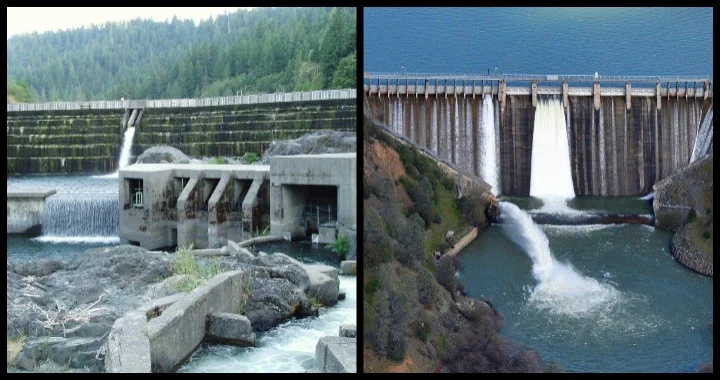From left: Cape Horn Dam, Scott Dam. Photos: PG&E.
UPDATE, 1:08 p.m.: Here’s a statement from the County of Humboldt on PG&E’s plans.
###
Could the dams on the upper Eel River be coming down for good?
Late last week, PG&E issued a 2,000-plus-page plan to decommission and demolish its two dams on the upper stretches of the Eel River – Scott Dam and Cape Horn Dam, in Lake County and Mendocino County, respectively. These long-troubled dams were built over 100 years ago for the purpose of generating electricity, and had the side effects of rerouting water from the Eel River into the Russian River watershed. Also, they blocked fish passage into a bunch of prime habitat.
The dams have long
been unprofitable, PG&E has
been trying to get rid of them since at least 2018. They haven’t
generated any power at all since 2011 2021. Now the utility is ready to take
them down.
It all might be a lot more straightforward if not for the big interests that have grown up around the Eel River water that has, for the last century, been diverted into the Russian. When the dams first fired up, no one much cared which way the water went to the sea. It was all about generating power. But since then, agribusiness and development in the Mendocino/Sonoma/Marin corridor have come to depend on that water for their operations.
Under PG&E’s plan – you can download it here in full – both dams would be removed fairly rapidly. In their place, a new facility will be built at the site of the former Cape Horn Dam to continue to supply water to the Russian River watershed. This would be called the NERF – the “New Eel-Russian Facility.” It’s not yet clear how much water would be diverted at the NERF, but it could presumably be limited to winter months and vary depending on the wetness of the year.
“The framework here is that we will only agree to a diversion that has zero ecological impacts on the Eel,” said Scott Greacen, conservation director of Friends of the Eel, in a phone conversation with the Outpost this morning.
The main thing, for proponents of Eel River restoration, is to open up salmon and steelhead habitat beyond the dams. Cape Horn has a very bad fish ladder, and Scott Dam has no fish ladder at all. Removing those barriers could be a particular boon for summer-run steelhead, a threatened population on the North Coast.
PG&E is giving an online public presentation on their final decommissioning plan tomorrow, Feb. 6, from 10 to 11:30 a.m. Here’s the link. Public comments on the document — which will be submitted to the Federal Energy Regulatory Commission — are due by March 3.

CLICK TO MANAGE